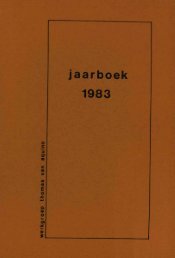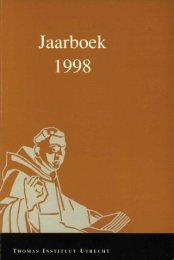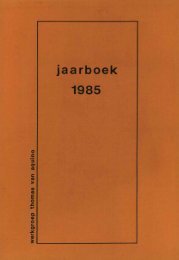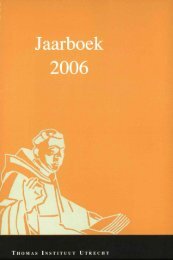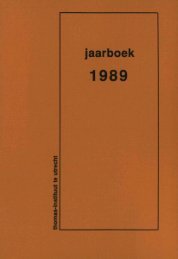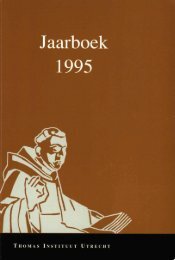Jaarboek Thomas Instituut 1997 - Thomas Instituut te Utrecht
Jaarboek Thomas Instituut 1997 - Thomas Instituut te Utrecht
Jaarboek Thomas Instituut 1997 - Thomas Instituut te Utrecht
You also want an ePaper? Increase the reach of your titles
YUMPU automatically turns print PDFs into web optimized ePapers that Google loves.
HOW TO TALK TO STRANGERS<br />
Aquinas and In<strong>te</strong>rreligious Dialogue<br />
in the Middle Ages<br />
Pim Valkenberg<br />
Was <strong>Thomas</strong> Aquinas a predecessor of modem efforts towards<br />
in<strong>te</strong>rreligious dialogue? This is a question that will not be answered in<br />
this article, since it disregards the differences between the theological<br />
propensity of Aquinas and the particularities of our modem, pluralistic<br />
age. However, it is possible to answer this question indirectly, because<br />
there is something in common between Aquinas' manner of speaking<br />
to strangers and a modem understanding of religious plurality. It is the<br />
necessity of explaining one's faith to others, which uni<strong>te</strong>s such diverse<br />
procedures as polemics, apologetics, and in<strong>te</strong>rreligious dialogue.<br />
1. Introduction<br />
One of the most remarkable features of modern Roman Catholic<br />
theology since the Second Vatican Council is its growing awareness of<br />
religious plurality. In spi<strong>te</strong> of its descent from the Jewish religion,<br />
Christianity never seemed to bother about other religions during most<br />
of its Wes<strong>te</strong>rn history, until the shock of the Holocaust recalled the<br />
fa<strong>te</strong> of the Jewish people to mind. At least for Roman Catholic<br />
theology, the declaration of the Vatican Council Nostra Aeta<strong>te</strong> on the<br />
relation of the Church to non-Christian religions, marked the<br />
beginning of a new awareness. This declaration, originally meant to<br />
address the Jewish people, widened its horizon to include Islam,<br />
Hinduism and Buddhism as well'.<br />
On the history of Nostra Aeta<strong>te</strong>, see M. Ruokanen, The Catholic<br />
Doctrine of Non-Christian Religions according to the Second Vatican Council,<br />
Leiden 1992.



